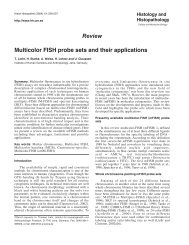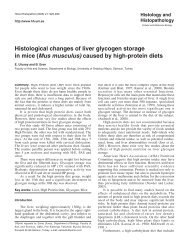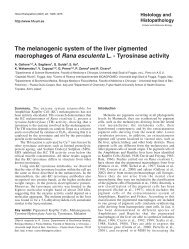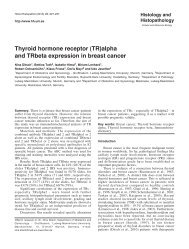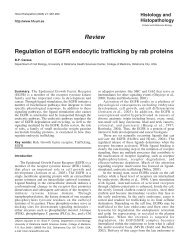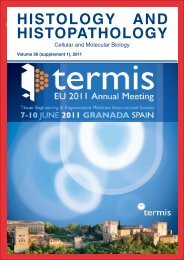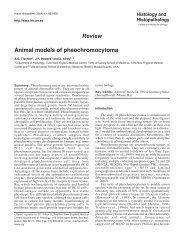Full text-PDF - Histology and Histopathology
Full text-PDF - Histology and Histopathology
Full text-PDF - Histology and Histopathology
You also want an ePaper? Increase the reach of your titles
YUMPU automatically turns print PDFs into web optimized ePapers that Google loves.
786<br />
Annulate lammellae in Torpedo hepatocytes<br />
liver specimens were cut in 1 mm- thick slices <strong>and</strong> fixed<br />
promptly at laboratory temperature (15°C) for 10 min in<br />
3% glutaraldehyde diluted by sea water, <strong>and</strong> buffered by<br />
0.1 M cacodylate buffer. Fixative was then changed <strong>and</strong><br />
specimens were immersed for another 2 hours at 4°C<br />
before they were washed by the buffer alone containing<br />
30 gm/L sodium chloride <strong>and</strong> 2 gm sucrose. Tissues<br />
were postfixed with a 2% aqueous osmium tetraoxide<br />
solution for 2h duration. Tissue samples were then<br />
processed <strong>and</strong> embedded in PolyBed 812 (Polysciences,<br />
Warrington, PA). Thin sections were observed in a Jeol<br />
101 transmission electron microscope.<br />
Results<br />
Torpedo display elongated, prismatic <strong>and</strong> polyhedral<br />
shaped hepatocytes from 15 to 25 µm in length <strong>and</strong> 5 to<br />
8 µm in width, <strong>and</strong> 6 to 7 µm in height; they are mostly<br />
uninucleate <strong>and</strong> contain very large amounts of storage<br />
glycogen as well as lipid droplets with dense bodies <strong>and</strong><br />
yolk deposits. The hepatocytes reveal irregular <strong>and</strong><br />
thick, microvilli extensions on their surfaces in the space<br />
of Disse (Fig. 1). A narrow 1.0 to 2.5 µm -thick<br />
bordering region of cytoplasm, rich in branching smooth<br />
endoplasmic reticulum, contains scattered mitochondrial<br />
profiles <strong>and</strong> bundles of actin-like filaments. These<br />
organelles appear to be confined to the encompassing<br />
cytoplasm among these filaments. Mitochondria, oblong<br />
to round shaped (1.5 µm long <strong>and</strong> 0.3-0.5 µm in<br />
diameter) display exaggerated electron densities, a<br />
poorly developed matrix, appears somewhat vacuolated<br />
<strong>and</strong> sometimes display minute whorls.<br />
The unique observation made throughout the 5 liver<br />
specimens of this selachian is the presence of unusual<br />
circular ALs surrounded by glycogen <strong>and</strong> lipid deposits.<br />
In addition, pieces (?) or linear segments of AL can be<br />
detected near the circular AL <strong>and</strong> at the edge of these<br />
storage components. The large glycogen storages<br />
typically segregate other organelles as expected in the<br />
hepatocytes. However, the glycogen aggregates appear<br />
spread as a dense network instead of rosettes as viewed<br />
in a more classic macromolecular storage. In addition,<br />
within the glycogen storage component, lysosomal (?)<br />
whorls of membrane appear as onion bodies. This type<br />
of AL has unique, ultrastructural features, again because<br />
it is circular <strong>and</strong> it comprises two concentric rings of<br />
nuclear-like pore complexes each s<strong>and</strong>wiched between<br />
two narrow smooth endoplasmic reticulum (SER)<br />
cisternae. The innermost <strong>and</strong> outermost SER cisterns are<br />
contiguous <strong>and</strong> continuous with some SER tubular<br />
cross-sections outside the ALs; these are also adjacent to<br />
the main glycogen deposits of the central storage area of<br />
the hepatocyte. The inner ring contains a central area of<br />
cytoplasm filled with glycogen, lipid deposits, <strong>and</strong><br />
smooth endoplasmic reticulum. A narrow cytoplasmic<br />
zone is s<strong>and</strong>wiched between the inner <strong>and</strong> the outer rings<br />
of AL-SER complexes <strong>and</strong> also contains sparse but<br />
delicate aggregates of glycogen-like storage.<br />
Discussion<br />
The intention of this report is not to describe the<br />
general architecture of the liver in this species that will<br />
be the object of another contribution but to describe a<br />
peculiar AL morphology present in this differentiated<br />
tissue. From these observations, the hepatocytes found in<br />
the Torpedo samples were of the same anatomical<br />
structure as that characterized by other works (Diaz <strong>and</strong><br />
Connes, 1988; Rocha et al., 2001).<br />
The name annulate lamellae (AL) varied early on,<br />
but the advances in electron microscopy allowed the<br />
study <strong>and</strong> description of AL occurrence, <strong>and</strong> their<br />
organization. However a full underst<strong>and</strong>ing of their tridimensional<br />
architecture as well as their function in<br />
cellular homeostasis needs further elucidation. In this<br />
report, we propose that the ALs observed originated<br />
from a spiral structure that could unwrap <strong>and</strong> dissect out<br />
small pieces, i.e. the segments found among the other<br />
organelles. The molecular organization of ALs has been<br />
related to the cell cycle <strong>and</strong> dissected by several groups<br />
(Dabauvalle <strong>and</strong> Scheer, 1991; Cordes et al., 1995, 1996;<br />
Meier et al., 1995; Dabauvalle et al., 1999; Beckheling<br />
et al., 2003). These recent publications help us to<br />
underst<strong>and</strong> the early studies reporting that AL usually<br />
belong to cells that have active cell cycles or are<br />
prepared to undergo mitosis, such as animal <strong>and</strong> human<br />
cell lines (Wischnitzer, 1970; Kessel, 1983, 1992),<br />
including gametes or early division after fertilization<br />
(Billard 1984; Romeo et al., 1992), embryonic cells<br />
(Benzo, 1972, 1974), <strong>and</strong> pathologic ones (Kato et al.,<br />
2001), including injured liver cells (Hruban et al.,<br />
1965a,b; Kohda et al., 1989), hepatomas <strong>and</strong> other<br />
tumors (Hoshino, 1963; Svoboda, 1964; Ma <strong>and</strong> Webber,<br />
1966; Locker et al., 1969; Kim et al., 1990; Eyden,<br />
2000; Biernat et al., 2001) <strong>and</strong> in virus-infected cells<br />
(Marshall et al., 1996). Additionally, recent data<br />
confirmed that ALs are associated with the complex<br />
control <strong>and</strong> regulation of the initial steps leading to the<br />
pre-mitotic phase of the cell cycle (Cordes et al., 1996;<br />
Beckheling et al., 2003), including the disassembly <strong>and</strong><br />
reassembly of the nuclear envelope (Erl<strong>and</strong>son <strong>and</strong> De<br />
Harven, 1971; Meier et al., 1995; Cordes et al., 1996).<br />
Furthermore, the presence of glycogen <strong>and</strong> lipids in<br />
these hepatocytes is not a surprise as this organ is the<br />
main reserve storage of glycogen <strong>and</strong> this storage favors<br />
segregation of organelles (Bruslé <strong>and</strong> González I<br />
Anadon (1996). Even though we managed to preserve<br />
the tissue as soon as the fish was captured, <strong>and</strong><br />
according to previous literature (Spielberg et al., 1993),<br />
one observed the glycogen clumped into loose<br />
aggregates, not forming the rosettes morphology as<br />
classically described <strong>and</strong> detected many droplets of fatty<br />
deposits found throughout hepatocytes were well<br />
preserved. As in other selachians, the lipid reserve is rich<br />
in squalene <strong>and</strong> dense bodies (Peyronel et al., 1984;<br />
Rocha et al., 2001; Sarasquete et al., 2002) that could<br />
make the liver cells more susceptible to lipophilic toxic




